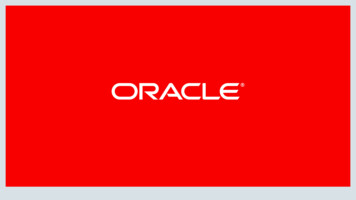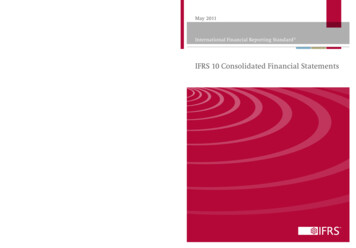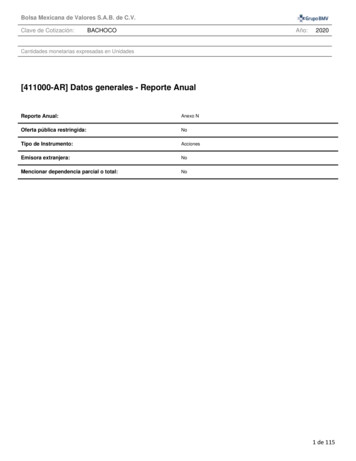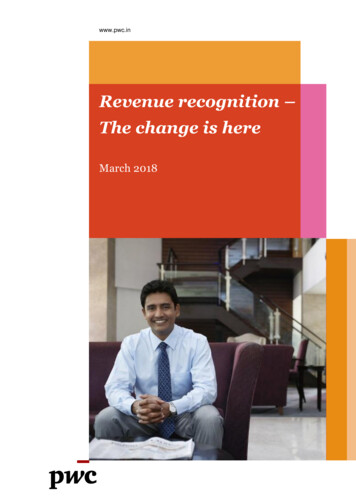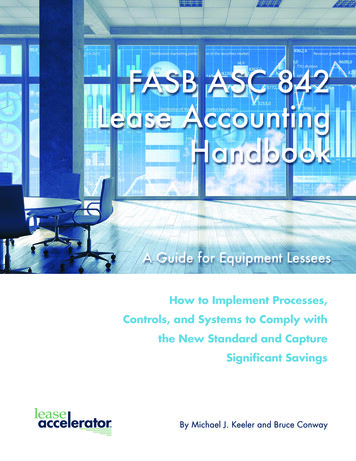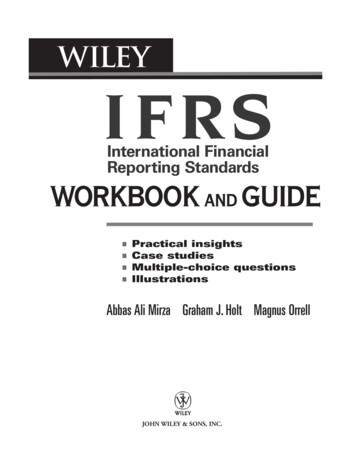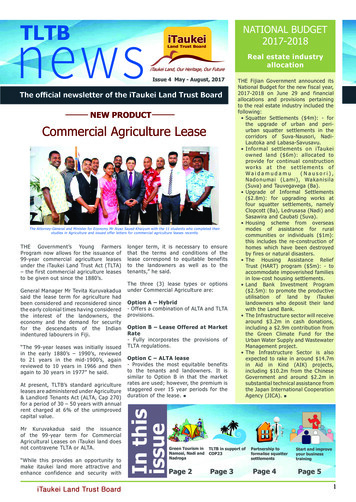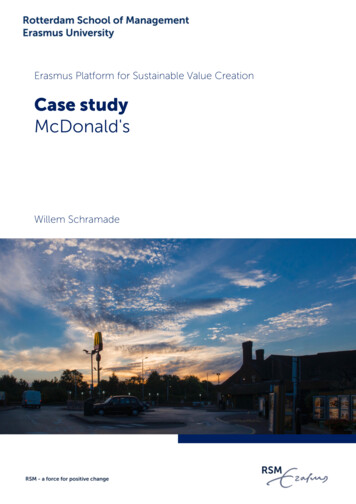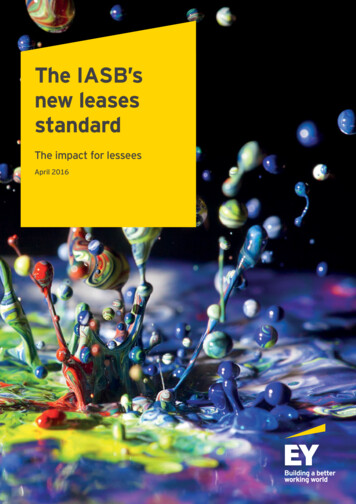
Transcription
The IASB’snew leasesstandardThe impact for lesseesApril 2016
IFRS 16: new requirements for accountingfor leasesThe IASB has issued a new leasing standard,IFRS 16 Leases, which will replace the existingIFRS requirements on lease accounting. TheIASB issued its standard as part of a joint projectwith the Financial Accounting Standards Board(FASB), however, the IASB and FASB madedifferent decisions and differences between thenew standards exist. IFRS 16 requires lessees to recognise mostleases on their balance sheets. Lessees have a single accounting model for allleases, with certain exemptions. IFRS 16 requires the disclosure of newinformation about leases that hasn’t previouslybeen required. The new standard is effective for periodsbeginning on or after 1 January 2019 withlimited early application permitted. Being proactive is important to support efficientand effective accounting and operationalchanges.This brochure provides an overview of thenew requirements for lessees, as well as ourrecommended approach for an effective transitionin a way that mitigates disruption, cost and risk.EY can advise and support you in implementingthe new standard, through the design of aneffective road map to manage your organisation’sIFRS 16 change journey. Processes and controls necessary to capture thetype of financial and non-financial data neededto apply the standard may require enhancement. Implementing IFRS 16 will affect many activitiesacross an organisation, including procurement,commercial, IT and finance functions.The IASB’s new leases standard The impact for lessees 1
IFRS 16: identifying a leaseDetermining when a customer has the right to direct the use of an identified asset mayrequire significant judgement, particularly for arrangements that includesubstantial services.Definition of a leaseAndIdentified assetRight to control the use of theidentified assetRight to obtainsubstantially allthe economicbenefitsRight to directthe useIFRS 16: lessee accountingLessees recognise most leases on balance sheet, with exemptions for leases oflow-value assets and short-term leases.Initial recognition andmeasurementSubsequentmeasurementMeasure the right of use (ROU) asset¹ and lease liabilityat present value of lease payments.ROUassetDepreciate the ROU asset based on IAS 16, or usealternative measurement basis under IAS 16 and IAS 40,if applicable.LiabilityAccrete liability based on the interest method, usinga discount rate determined at lease commencement².Reduce the liability by payments made.Profit and lossInterest and depreciation are recognisedand presented separately.Generally front loaded expense for an individual lease.1. Initial measurement of the ROU asset would also include the lessee’s initial direct costs; prepayments made to the lessor, less lease incentives received from the lessor, if any; and restoration, removaland dismantling costs.2. As long as a reassessment and a change in the discount rate have not occurred.2 The IASB’s new leases standard The impact for lessees
IFRS 16: factors affecting complexityThe new standard will affect lessees across many industry sectors. The scale of impactis typically driven by the volume of operating leases and whether they contain multiplecomponents such as lease and non-lease components.Less complexMore complex Majority of current leases classified as finance leases Majority of current leases classified as operating leases Contracts of less than one year and leases of low-value assets Long-term contracts, such as commercial property Lease contract data readily available and easily accessible Lease contract data not readily available, e.g., stored manually,in multiple locations Centralised operations and processes Decentralised operations and processes Contracts do not contain non-lease components Lease contracts contain both lease and non-lease elements Lease portfolio contains similar assets, terms and conditions Standard, straightforward lease contract terms and consideration Lease portfolio contains dissimilar assets, terms and conditions Lease contracts contain variable consideration and renewal,purchase and termination optionsIFRS 16: initial application for lesseesEarly preparation will be key to a successful implementation of the new standard.Early preparationrecommended due topotential complexity and widerange of challenges2016201720182019Comparative periodReporting period1/2Full retrospective approachAvailable preparation time less than two yearsIFRS 16IFRS 16Opening balance sheet1 Jan 20181/3Modified retrospective approachAvailable preparation time less than three yearsIAS 17/IFRIC 4IFRS 16Opening balance sheet1 Jan 20191. There is no requirement to reassess on transition whether a contract contains a lease.2. Assumes one comparative period. Some jurisdictions or regulatory environments may require more than one comparative period.3. Several practical expedients are available when applying the modified retrospective approach, including a transition exemption for existing operating leases ending within 12 months.The IASB’s new leases standard The impact for lessees 3
IFRS 16: scope of business impactThe new standard is more than just an accounting change. There are multiplecommercial and operational factors to consider. External audit Accounting policy System architecture Investor relations Financial reporting Covenant management Financial control Systems of record, chartof accounts, workflow Cash tax, effective taxrate and tax reporting Budgeting, forecastingand planning Assurance frameworkExternalreporting, tax Internal auditInternalcontrolManagementreporting Management informationdesign Balance sheetreconciliations Working capitalmanagement People capabilities Learning anddevelopment Bonus and incentiveschemes4 Data taxonomy and standardsFinance Audit committee Impact on financialmetrics and KPI design System supplierrelationships The IASB’s new leases standard The impact for lesseesPeople,performanceand reward Data cleanse and remediationIT systemsIFRS 16outcomes:compliance, cost and riskCurrentchangeprogrammes Identification of contracts thatcontain a leaseData governanceand managementCommercial,sales andmarketingProcurementand legal Data model design Lease contract design Lease contract management Impacts on use of off-balancesheet financing strategies Examples: financetransformation Lease contractacquisition process Scope, requirements,timing and quality Impact on lease termsand conditions
IFRS 16: implementation approachAdoption with minimum disruption. A successful step-by-step approach.1Before getting started with the full execution, you may benefit from a:Sample lease contract review(commercial, operational,accounting)1b. Analyseand planPhases Create plan3Disclosure review,including datatraceability testing2. Developand pilot3. Deploy andmonitor Assess widerbusiness impact Complete detaileddesign Deploy service to allsites Verify judgementsmade Draft road map andhigh-level services Pilot services andrefine Parallel run Update documents Monitor and test Remediate systemschanged1a. Assess Assess financialstatement andoperational impact2Contract managementcapability review Draft leasingpolicies andprocedures Remediate andregression test4. Monitor postimplementation Embed training Plan deploymentWork streamsGovernance and programme managementLease accounting and disclosure, forecasting, budgeting and planningSystems and lease data captureProcess and controlChange management and trainingThe IASB’s new leases standard The impact for lessees 5
EY Assurance Tax Transactions AdvisoryYour EY contactsAt EY we have developed an approach that can be tailored tomeet your specific requirements around IFRS 16 readinessassessment, implementation and compliance.* Your EYIFRS 16 contact will be able to give you more insights on thestandard, provide guidance on potential areas of impact andguide you through the steps for a successful adoption at alimited cost.EMEIA IFRS 16 contactsAbout EYEY is a global leader in assurance, tax, transaction and advisoryservices. The insights and quality services we deliver help build trust andconfidence in the capital markets and in economies the world over. Wedevelop outstanding leaders who team to deliver on our promises to allof our stakeholders. In so doing, we play a critical role in building a betterworking world for our people, for our clients and for our communities.EY refers to the global organization, and may refer to one or more, ofthe member firms of Ernst & Young Global Limited, each of which isa separate legal entity. Ernst & Young Global Limited, a UK companylimited by guarantee, does not provide services to clients. For moreinformation about our organization, please visit ey.com.About EY’s Financial Accounting AdvisoryName:EMEIA IFRS 16 LeaderTel:Email:Visit our website ey.com/IFRSServices The changing accounting and reporting landscape provideschallenges for multinational companies as they seek to respond toglobal market conditions and report their financial results while facingincreased scrutiny from a range of stakeholders.EY’s accounting, regulatory, compliance and information technologyprofessionals combine technical experience with business and industryinsights to help clients navigate complexity. Whether your focus is onmanaging highly technical accounting requirements or addressinggovernance and regulatory issues, having the right advisors on your sidecan make all the difference.Our team uses proven and integrated methodologies to help you resolveyour challenging business problems, deliver accurate financial reports incomplex market conditions and make sustainable improvements for thelonger term. We understand that you need services that are adapted toyour specific industry issues, so we bring our broad sector experienceand deep subject matter knowledge to your projects in a proactive andobjective way. 2016 EYGM Limited.All Rights Reserved.EYG no. 01050-163GblBMC AgencyGA 0000 05753ED NoneThis material has been prepared for general informational purposes only and is not intended tobe relied upon as accounting, tax, or other professional advice. Please refer to your advisors forspecific advice.ey.com* Note: Certain of our services for an audit client and its affiliates may be morelimited in order to comply with applicable independence standards. Please speakto your EY contact for further information.
01.01.2019 · IFRS requirements on lease accounting. The IASB issued its standard as part of a joint project with the Financial Accounting Standards Board (FASB), however, the IASB and FASB made different decisions and differences between the new standards exist. IFRS 16 requires lessees to recognise most leases on their balance sheets. Lessees have a single accounting model for all File Size: 700KBPage Count: 8Financial reporting developments: Exit or disposal cost .09.04.2019A closer look at IFRS 16 Leases Presentation and disclosure requirements of IFRS 16 Leases See more results
